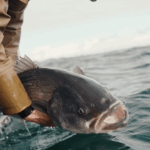
Release Mortality Revisited: New Research from Massachusetts DMF
Feature Photo Credit: Robbie Tartaglia What’s going on? For decades, striped bass management relied on a
It’s been another explosive year for bluefin tuna anglers up and down the east coast, with fish from 40-inch footballs to 100-plus-inch jumbos bending rods, ripping drag, breaking gear (and hearts), and sometimes even hitting the deck or coming boatside for release. But how does that relate to what fisheries scientists are seeing for the overall stock?
Last fall, we reported on the 2020 stock assessment update for Western Atlantic bluefin, which puzzled many anglers in its call for a reduction in total allowable catch (TAC) even as folks were seeing more fish than ever before. Ultimately, the International Commission for the Conservation of Atlantic Tunas (ICCAT) elected to punt on setting new catch limits for the fishery in 2021, opting instead to maintain the 2020 TAC of 2,350 metric tons (mt; about 5 million pounds) for 2021 (about half of the TAC goes to the United States). One condition of that decision, however, was that ICCAT’s Standing Committee on Research and Statistics (SCRS) conduct another assessment for the stock in 2021 to inform management for subsequent years.
That brings us to this fall, when the SCRS released the findings of its stock assessment and related management advice in advance of 2021 ICCAT (virtual) annual meeting, which begins on November 15. Below, we detail what the scientists found, their management advice, and what we view as the best path forward.
The 2021 Stock Assessment: A Summary
Drs. John Walter and Craig Brown, both of the NOAA Fisheries Southeast Fisheries Science Center, gave stakeholders a thorough rundown of the stock assessment’s findings at public meetings of the U.S. ICCAT Advisory Committee on September 30 and October 18. For those interested in learning about the stock assessment in greater detail, check out the SCRS report (beginning on page 47).
The 2021 stock assessment differed from the previous year’s assessment update in several ways. First, of course, it included more data—two more years of the indices, including everything from larval surveys to various fishery harvests of giant bluefin, which provide the raw abundance and size/age distribution data entered into the stock assessment models. Second, some of these indices were modified from previous years—for example, the two survey indices for juvenile bluefin, based on recreational catch estimates on the east coast, were combined into a single index. Third, stock assessment model assumptions around the size selectivity of the fisheries used in the indices—how well the fish caught represented the sizes of fish that were actually in the water—were revised.
Only one of the two stock assessment models used, called Stock Synthesis, was deemed suitable for management advice by the SCRS. And it found significant differences from the comparatively gloomy outlook we reported on last year. For example, it did not see a long-term decline in recruitment (the number of juvenile bluefin tuna entering the fishery), but rather several years of strong recruitment, and 2017 was detected as one of the best recruitment years in four decades. This change was due both to the estimates of increased juvenile abundance coming from our recreational fishery and changes in how that index was calculated.
Overall, the new stock assessment determined that overfishing of the Western Atlantic bluefin tuna stock was not occurring and that the current Western Atlantic TAC of 2,350 mt has a 0% probability (a rarity in fisheries management) of leading to overfishing. While the 2020 assessment estimated an 11.7% decrease in biomass from 2017-2020, the 2021 assessment estimated a 9% increase. It is worth noting that while things are looking up, the stock assessment still estimates a stock size well below the historical average—18% of 1950 biomass and 46% of 1974 biomass.
The stock assessment did, however, contain significant uncertainties, and an independent review recommended against using its conclusions for management advice, which Dr. Walter referred to as “a little sobering.” Some of the major uncertainties included “mixing between the stocks, recruitment, age composition, age at maturity, the possibility of regime shifts, assumptions regarding selectivity, and indices of abundance.” For example, the changes in selectivity assumptions increased the estimate of the fishing mortality level that would lead to overfishing by 35%. Overall, the new fishery data and the revision of the indices were responsible for only about a third of the change in findings from 2020; the shift in model assumptions, meanwhile, contributed to two thirds of the different, rosier picture we are now seeing.
As a result, the SCRS recommended that its management advice, as reflected in the Kobe matrix below (probability of not experiencing overfishing at different catch levels) should be interpreted with caution:

Where Do We Go from Here?
All of this puts managers in a not-unfamiliar position—what to do in the face of scientific uncertainty? What’s an acceptable level of risk given the current quota and state of the fishery?
There’s no silver bullet, but understanding the context of decision-making for 2022 is important. ICCAT’s scientists (with input from managers and stakeholders) are currently developing a Management Strategy Evaluation, or MSE, for the Atlantic-wide bluefin tuna fishery. This new approach will represent a significant departure from how we currently manage bluefin tuna in many ways, but most notably, it will explicitly incorporate mixing between the eastern and western Atlantic stocks when setting catch limits. This is no small shift given that the eastern stock is around 10 times larger than the western stock, and that in some cases it’s estimated that over three quarters of the bluefin tuna off our coast originate from the east. MSE is slated to come online in time to set 2023 catch limits, so the current decision is really only a one-year stopgap measure.
While we’re not opposed to a small increase in the TAC for 2022—perhaps a 4% increase of around 100 mt, which was one of the options proposed by the SCRS—we’re not in favor of opening the floodgates for one year given the large uncertainties and the impending shift in management approach. The current TAC is already the highest it’s been in 15 years, and we’re not hearing many recreational folks up and down the coast saying that the current management measures are too restrictive—in numerous cases, in fact, quite the opposite.
In conclusion, this is all good news, especially in comparison to where we thought we were a year ago. More small fish, a better outlook for the fishery, and a new management paradigm that better reflects stock dynamics on the horizon. We’ve encouraged managers to take a risk-averse approach when it comes to setting 2022 catch limits to position the fishery for long-term success, and will be tracking the ICCAT meeting’s outcomes closely. Stay tuned.

Feature Photo Credit: Robbie Tartaglia What’s going on? For decades, striped bass management relied on a

Recent developments in the 2025 Atlantic Menhaden Stock Assessment Update, released by the Atlantic States

What’s going on? The “most important fish in the sea” just exposed one of the

Mario CampoFisheries Ecologist, Southeastern Louisiana UniversityScience and Policy Associate, American Saltwater Guides Association This discussion
We rely on our members and donations to keep fighting for a sustainable tomorrow in marine conservation.
GIVE THE GIFT OF FISHERIES CONSERVATION THIS HOLIDAY SEASON. SHOP ASGA GOODS THAT FUND FISHERIES RESEARCH & ADVOCACY CAMPAIGNS
JOIN ASGA IN CALLING FOR CRITICAL MANAGEMENT ACTION AFTER YEARS OF SPAWN FAILURES & POOR MANAGEMENT.
By using this website, you agree to our use of cookies. We use cookies to provide you with a great experience and to help our website run effectively. To learn more, please review our privacy policy.
One Response